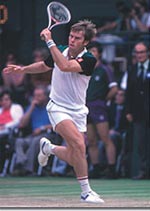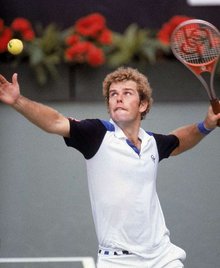Looking Back: Roscoe Tanner, Tennis Bad Boy

Roscoe Tanner won the 1977 Australian Open and was a finalist at Wimbledon in 1979.
Blond, beautiful, athletic—filled with untapped promise, Roscoe Tanner should be among our heroes in tennis. Instead he sits atop a rare list of tennis gone-bad boys.
Tanner remains one of the finest tennis players of the 1970s. In 1977, he won the Australian Open and in 1979 played Bjorn Borg to a trauma-inducing final at Wimbledon, extending him to five sets before finally falling to the mystique and iron will of the ice man.
The significance of that match goes beyond the intensity of its level of competition. It was the first live broadcast of Breakfast at Wimbledon, now a tradition to tennis loving fans in the United States.
NBC had prayed for John McEnroe or Jimmy Connors to meet Borg in the finals. Instead, they got Roscoe Tanner, who played the match of his life. We owe the continuation of the early morning live broadcast to him for making it memorable.
Long before the days of high-tech rackets, Roscoe Tanner was scorching the earth with serves that set many an opponent back on his heels wondering what just flew by.
He is the father of the lethal serve—plus he was a lefty, which gave him a further advantage because the serve came from an angle his opponents were not used to or ready for, an advantage Rafael Nadal has evolved into an art form.

Tanner's serve was clocked at an astonishing 153 miles per hour.
Tanner’s February 1978 serve of 153 mph was the fastest recorded serve in tennis history until Andy Roddick broke it in September of 2004 with a serve of 155 mph.
In the ’70s, clocking serves was not typically done, nor was it accomplished with the accuracy it is today. But every player knew of the sheer power of Tanner’s serve and dreaded meeting Roscoe in any round of any tournament.
During his tennis career, Tanner was ranked as high as No. 4 in the world. He was the first player of significance to play tennis at Stanford University and he helped establish it as an NCAA tennis dynasty.
Not only did Roscoe play tennis supremely well, he had a magnetic personality that drew people around him. He was outgoing and handsome, came from a good family, and had Stanford credentials. In the ’70s, Roscoe made a great deal of money on tour and with endorsements.
So how could this man who had the world in the palm of his hand fail so utterly as a human being? And fail he did, in no uncertain terms! As you survey the life and times of Roscoe Tanner, you unveil a perfect role model for a sociopath.
Tennis fit right in to Roscoe’s innate ability to compartmentalize his life. Someone commented that Roscoe played tennis well because he could concentrate solely on the ball and not on his opponent. Opponents can be distracting—but keeping your eye on the ball is the chief ingredient for success on court.
Being able to compartmentalize your life means always seeing things from your own perspective. You are the center of your life and everything you do relates to your perceived goals and ambitions. There is no one sharing the spotlight with you.
This translated into magnificent tennis because most of Tanner’s efforts in the ’70s were devoted to playing the game he was meant to play.
Keeping distractions to a minimum and seeing the panorama across the net and into the stands from his vantage point all worked to seal his success.
But while tennis thrived, the rest of Tanner’s life grew suspect. He was popular because he told people what they wanted to hear. It was expeditious. He did it to please. There was never a malicious intent in his actions.
He fell effortlessly into the trap of being a womanizer. He cheated on all his wives without feeling it was wrong because he needed it to fill his ego, and as long as she didn’t know, Tanner felt there was nothing wrong.
He had no moral compass. Yet, no one quite recognized that fact until much later.
There were hints at aberrant behavior all along. He would have sudden outbursts of temper and then turn them off, automatically returning to his charming ways. He would ignore his parents, who flew across the country to see him play. He had a high-pitched giggle that used to raise eyebrows.
Toward the end of his career, he injured his elbow, and this contributed to his ultimate decline and led him to retire from professional tennis in 1984. ESPN had signed Tanner to do commentary and everyone was confident it was just another step in his fine tennis career.
It marked the beginning of his steady decline into ignominy.
He cheated friends, family, and fellow tennis professionals out of money, always promising but never delivering on schemes to get rich by banking on his fame.
He has been married three times, divorced twice, and sued for child-custody support. He has been jailed numerous times for failure to pay child support, as well as for felony charges of theft. He was incarcerated in Germany and later expedited to the United States for fleeing prosecution.
He is a sexual addict, a pathological liar, and cannot honor his commitments to anyone or anything. He is the perfect sociopath. There are 10 general symptoms: (1) not learning from experience, (2) no sense of responsibility, (3) inability to form meaningful relationships, (4) inability to control impulses, (5) lack of moral sense, (6) chronically antisocial behavior, (7) no change in behavior after punishment, (8) emotional immaturity, (9) lack of guilt, (10) self-centeredness.
He was once arrested and hauled off to jail at a senior tennis event for failure to pay child support. Upon his return, he received a standing ovation from assembled friends. He is chronically broke and usually one step ahead of being jailed.
Tanner was arrested in May of 2008 for writing bad checks—two of them for two Toyota Highlanders. Once the vehicles were returned and Tanner paid $5,000 in restitution, the charges were dropped.
He remains a charmer continually puzzling family and friends with his bizarre behavior—but there is no cure for sociopathic behavior. We all know a Roscoe Tanner perhaps better than we wish…
The man with the golden arm who dazzled the world with his powerful serves now only serves time—waiting for his next opportunity to bounce one over the net…
Note
Two seminal articles on Roscoe Tanner are Outside Looking In, by L. Jon Wertheim of Sports Illustrated, written in November of 2004, and Jailed Tanner’s Losses: Game, set, match…family, by Greg Garber of ESPN.com, written in June of 2006.
I highly recommend both as examples of first-rate tennis journalism. They were both inspiring to me.
JA Allen is a regular contributor for Sports Then and Now.









